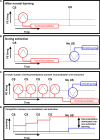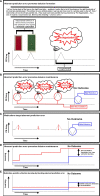Why do delusions persist?
- PMID: 19636384
- PMCID: PMC2713737
- DOI: 10.3389/neuro.09.012.2009
Why do delusions persist?
Abstract
Delusions are bizarre and distressing beliefs that characterize certain mental illnesses. They arise without clear reasons and are remarkably persistent. Recent models of delusions, drawing on a neuroscientific understanding of learning, focus on how delusions might emerge from abnormal experience. We believe that these models can be extended to help us understand why delusions persist. We consider prediction error, the mismatch between expectancy and experience, to be central. Surprising events demand a change in our expectancies. This involves making what we have learned labile, updating and binding the memory anew: a process of memory reconsolidation. We argue that, under the influence of excessive prediction error, delusional beliefs are repeatedly reconsolidated, strengthening them so that they persist, apparently impervious to contradiction.
Keywords: delusions; extinction; habit; prediction error; reconsolidation; salience.
Figures


Similar articles
-
Ketamine effects on memory reconsolidation favor a learning model of delusions.PLoS One. 2013 Jun 12;8(6):e65088. doi: 10.1371/journal.pone.0065088. Print 2013. PLoS One. 2013. PMID: 23776445 Free PMC article.
-
Understanding Cognitive Behavioral Therapy for Psychosis Through the Predictive Coding Framework.Biol Psychiatry Glob Open Sci. 2024 May 13;4(4):100333. doi: 10.1016/j.bpsgos.2024.100333. eCollection 2024 Jul. Biol Psychiatry Glob Open Sci. 2024. PMID: 38952435 Free PMC article. Review.
-
The doxastic shear pin: delusions as errors of learning and memory.Cogn Neuropsychiatry. 2016;21(1):73-89. doi: 10.1080/13546805.2015.1136206. Epub 2016 Feb 15. Cogn Neuropsychiatry. 2016. PMID: 26878311 Free PMC article.
-
The fate of memory: Reconsolidation and the case of Prediction Error.Neurosci Biobehav Rev. 2016 Sep;68:423-441. doi: 10.1016/j.neubiorev.2016.06.004. Epub 2016 Jun 7. Neurosci Biobehav Rev. 2016. PMID: 27287939 Review.
-
Disrupted prediction-error signal in psychosis: evidence for an associative account of delusions.Brain. 2007 Sep;130(Pt 9):2387-400. doi: 10.1093/brain/awm173. Epub 2007 Aug 9. Brain. 2007. PMID: 17690132 Free PMC article.
Cited by
-
A cognitive account of belief: a tentative road map.Front Psychol. 2015 Feb 13;5:1588. doi: 10.3389/fpsyg.2014.01588. eCollection 2014. Front Psychol. 2015. PMID: 25741291 Free PMC article.
-
Aberrant hippocampus and amygdala morphology associated with cognitive deficits in schizophrenia.Front Cell Neurosci. 2023 Feb 23;17:1126577. doi: 10.3389/fncel.2023.1126577. eCollection 2023. Front Cell Neurosci. 2023. PMID: 36909281 Free PMC article.
-
Enhancing Psychosis Risk Prediction Through Computational Cognitive Neuroscience.Schizophr Bull. 2020 Dec 1;46(6):1346-1352. doi: 10.1093/schbul/sbaa091. Schizophr Bull. 2020. PMID: 32648913 Free PMC article.
-
Rethinking delusions: A selective review of delusion research through a computational lens.Schizophr Res. 2022 Jul;245:23-41. doi: 10.1016/j.schres.2021.01.023. Epub 2021 Mar 3. Schizophr Res. 2022. PMID: 33676820 Free PMC article. Review.
-
Distinct Time-Course of Alterations of Groups I and II Metabotropic Glutamate Receptor and GABAergic Receptor Expression Along the Dorsoventral Hippocampal Axis in an Animal Model of Psychosis.Front Behav Neurosci. 2019 May 8;13:98. doi: 10.3389/fnbeh.2019.00098. eCollection 2019. Front Behav Neurosci. 2019. PMID: 31139061 Free PMC article.
References
-
- Alberini C. M. (2007). Reconsolidation: the samsara of memory consolidation. Debates Neurosci. 1, 17–2410.1007/s11559-007-9000-z - DOI
-
- Bartlett F. C. (1932). Remembering. Cambridge, Cambridge University Press
-
- Basan A., Leucht S. (2004). Valproate for schizophrenia. Cochrane Database Syst. Rev. CD004028. - PubMed
Grants and funding
LinkOut - more resources
Full Text Sources

